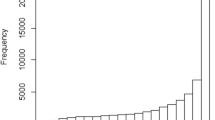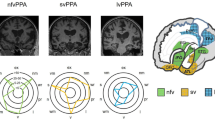Abstract
Hierarchical and overlapping cluster methods were applied to the sortings of aphasic, nonaphasic brain-damaged, schizophrenic, and normal subjects presented with 30 pictures of animals. The hierarchical structure solutions were most diffuse for the groups of the schizophrenics and the fluent aphasics. The structure for the nonfluent aphasics showed more clarity, but was also deviant from the structures of the normals and the brain-damaged without aphasia. Fluent aphasics but not nonfluent aphasics tended to sort pictures which they could not name into smaller groups. For the nonfluent aphasics, there was a significant correlation between the commonality of the sortings and the severity of aphasic disturbances as measured by the Token Test. The relationship between conceptual disorganization and language impairment seems to be functionally different for fluent and nonfluent aphasics.
Similar content being viewed by others
References
Armitage, S. G. (1946). An analysis of certain psychological tests used for the evaluation of brain injury.Psychol. Monogr. 60: Whole No. 277.
Barton, M., Maruszewski, M., and Urrea, D. (1969). Variation of stimulus context and its effect on word-finding ability in aphasics.Cortex 5:351–365.
Benson, D. F. (1967). Fluency in aphasia: Correlation with radioactive scan localization.Cortex 3:373–394.
Benson, D. F., and Geschwind, N. (1967). Shrinking retrograde amnesia.J. Neurol. Neurosurg. Psychiat. 30:539–544.
Bisiach, E. (1966). Perceptual factors in the pathogenesis of anomia.Cortex 2:90–95.
Bleuler, E. (1972).Lehrbuch der Psychiatrie, 12th ed., Springer, Berlin.
Bower, G. H. (1972a). Mental imagery and associative learning. In Gregg, L. W. (ed.),Cognition in Learning and Memory, Wiley, New York.
Bower, G. H. (1972b). A selective review of organizationl factors in memory. In Tulving, E., and Donaldson, W. (eds.),Organization of Memory, Academic Press, New York.
Brookshire, R. H. (1972). Effects of task difficulty on naming performance of aphasic subjects.J. Speech Hearing Res. 15:551–558.
Brown, R., and McNeill, D. (1966). The tip of the tongue phenomenon.J. Verb. Learn. Verb. Behav. 5:325–337.
Carler, F. J. (1969). A linguistic feature study of aphasic responses to a free word association task. Unpublished doctoral dissertation, University of Maryland.
Chapman, L. J., and Chapman, J. P. (1973).Disordered Thoutht in Schizophrenia. Appleton-Century-Crofts, New York.
Chapman, L. J., and Taylor, J. A. (1957). Breadth of deviate concepts used by schizophrenics.J. Abnorm. Soc. Psychol. 54:118–123.
Cohen, R., Hartmann, P., Engel, D., Kelter, S., List, G., and Strohner, H. (1975).Experimentalpsychologische Untersuchungen zur Linguistischen Erfassung Aphatischer Störungen, Konstanz.
Collins, A. M., and Quillian, M. R. (1969). Retrieval time from semantic memory.J. Verb. Learn. Verb. Behav. 8:240–247.
Cunningham, K. M., and Ogilvie, J. C. (1972). Evaluation of hierarchical grouping techniques: A preliminary study.Computer J. 15:209–213.
Deese, J. (1965).The Structure of Associations in Language and Thought, Johns Hopkins Press, Baltimore.
De Renzi, E., and Vignolo, L. A. (1962). The Token Test: A sensitive test to detect receptive disturbances in aphasics.Brain 85:665–678.
De Renzi, E., Falioni, P., Savoiardo, M., and Vignolo, L. A. (1966). The influence of aphasia and of the hemispheric side of the cerebral lesion on abstract thinking.Cortex 2:399–420.
De Renzi, E., Pieczuro, A., and Vignolo, L. A. (1968). Ideational apraxia: A quantitative study.Neuropsychologia 6:41–52.
De Renzi, E., Falioni, P., Scotti, G., and Spinnler, H. (1972). Impairment in associating colour to form, concomitant with aphasia.Brain 95:293–304.
Evans, F. J., and Kihlstrohm, J. F. (1973). Posthypnotic amnesia as disrupted retrieval.J. Abnorm. Psychol. 82:317–323.
Faglioni, P., Spinnler, H., and Vignolo, L. A. (1969). Contrasting behavior of right and left hemisphere-damaged patients on a discriminative and a semantic task of auditory recognition.Cortex 5:366–389.
Fillenbaum, S., and Rapoport, A. (1971).Structures in the Subjective Lexicon, Academic Press, New York.
Geschwind, N. (1967). The varieties of naming errors.Cortex 3:97–112.
Goldstein, K., and Scheerer, M. (1941). Abstract and concrete behavior: An experimental study with special tests.Psychol. Monogr.53: Whole No. 239.
Gordon, N. G. (1972). The Trail Making Test in neuropsychological diagnosis.J. Clin. Neuropsychol. 28:167–169.
Green, E. (1970). On the contribution of studies in aphasia to psycholinguistics.Cortex 6:216–235.
Hartje, W., Kerschensteiner, M., Poeck, K., and Orgass, B. (1973). Note: A cross-validation study on the Token Test.Neuropsychologia 11:119–121.
Hegenscheidt, M., and Cohen, R. (1972). Zur Erfassung der Umstellungsfähigkeit bei hirnorganisch geschädigten Personen.Z. Klin. Psychol. 1:1–20.
Henley, N. M. (1969). A psychological study of the semantics of animal terms.J. Verb. Learn. Verb. Behav. 8:176–184.
Howes, D. (1964). Application of the word-frequency concept to aphasia. In de Reuck, A. V. S., and O'Connor, M. (eds.),Ciba Foundation Symposium on Disorders of Language, Churchill, London.
Jakobson, R. (1971).Studies on Child Language and Aphasia, Mouton, The Hague.
Jardine, N., and Sibson, R. (1968a). The construction of hierarchic and nonhierarchic classifications.Computer J. 11:177–184.
Jardine, N., and Sibson, R. (1968b). A model for taxonomy.Math. Biosci. 2:465–482.
Jardine, N., and Sibson, R. (1971).Mathematical Taxonomy, Wiley, New York.
Johnson, S. C. (1967). Hierarchical clustering schemes.Psychometrika 32:241–254.
Kerschensteiner, M., Poeck, K., and Brunner, E. (1972). The fluency/nonfluency dimension in the classification of aphasic speech.Cortex 8:233–247.
Kintsch, W. (1970). Models for free recall and recognition. In Norman, D. A. (ed.),Models of Human Memory, Academic Press, New York.
Kintsch. W., Miller, R. F., and Hogan, R. M. (1970). Semantic Structure and Clustering in Free Recall, Technical Report, University of Colorado.
Koh, S. D., and Kayton, L. (1974). Memorization of “unrelated” word strings by young nonpsychotic schizophrenics.J. Abnorm. Psychol. 83:14–22.
Koh, S. D., Kayton, L., and Berry, R. (1973). Mnemonic organization in young nonpsychotic schizophrenics.J. Abnorm. Psychol. 81:299–310.
Koh, S. D., Kayton, L., and Schwarz, C. (1974). The structure of word storage in the permanent memory of nonpsychotic schizophrenics.J. Consult. Clin. Psychol. 42:879–887.
Kruskal, J. B. (1964). Multidimensional scaling by optimizing goodness of fit to a nonmetric hypothesis.Psychometrika 29:1–27.
Mandler, G. (1968). Association and organization: Facts, fancies, and theoris. In Dixon, T. R., and Horton, D. L. (eds.),Verbal Behavior and General Behavior Theory, Prentice-Hall, Englewood Cliffs, N.J.
Marshall, J. C., and Newcombe, F. (1966). Syntactic and semantic errors in paralexia.Neuropsychologia 4:169–176.
McGaughran, L. S. (1954). Predicting language behavior from object sorting.J. Abnorm. Soc. Psychol. 49:183–195.
McGaughran, L. S., and Moran, L. J. (1957). Differences between schizophrenic and brain-damaged groups in conceptual aspects of object sorting.J. Abnorm. Soc. Psychol. 54:44–49.
Miller, G. A. (1969). A psychological method to investigate verbal concepts.J. Math. Psychol. 6:169–191.
Miller, G. A. (1972). Englisch verbs of motion: A case study in semantics and lexical memory. In Melton, A. W., and Martin, E. (eds.),Coding Processes in Human Memory, Winston, Washington, D.C.
Oldfield, R. C. (1971). The assessment and analysis of handedness: The Edinburgh Inventory.Neuropsychologia 9:97–113.
Orgass, B., and Poeck, K. (1966). Clinical validation of a new test for aphasia: An experimental study on the Token Test.Cortex 2:222–243.
Orgass, B., and Poeck, K. (1969). Assessment of aphasia by psychometric methods.Cortex 5:317–330.
Payne, R. W. (1971). Cognitive defects in schizophrenia: Overinclusive thinking. In Hellmuth, J. (ed.)),Cognitive Studies, Vol. 2:Deficits in Cognition, Brunner/Mazel, New York.
Powell, A., Havnaer, J., and Wiggins, W. (1972). Organization and recall of pictures and words in children.Psychonom. Sci. 29:385–387.
Reitan, R. M. (1955). The relation of the Trail Making Test to organic brain damage.J. Consult. Psychol. 19:393–394.
Reitan, R. M. (1958). Validity of the Trail Making Test as an indicator of organic brain damage.Percept. Motor Skills 8:271–276.
Reitan, R. M. (1959).A Manual for the Administration and Scoring of the Trail Making Test, Indiana University Press, Bloomington, Ind.
Rinnert, C., and Whitaker, H. A. (1973). Semantic confusions by aphasic patients.Cortex 9:56–81.
Shuell, T. J. (1969). Clustering and organization in free recall.Psychol. Bull. 72:353–374.
Tulving, E. (1962). Subjective organization in free recall of “unrelated” words.Psychol. Rev. 69:344–354.
Tulving, E., and Donaldson, W. (eds.) (1972).Organization of Memory, Academic Press, New York.
Tulving, E., and Pearlstone, Z. (1966). Availability versus accessibility of information in memory for words.J. Verb. Learn. Verb. Behav. 5:381–391.
Tweney, R. D., Hoemann, H. W., and Andrews, C. E. (1975). Semantic organization in deaf and hearing subjects.J. Psycholing. Res. 4:61–73.
Weigl, E. (1968). On the problem of cortical syndromes: Experimental studies. In Simmel, M. L. (ed.),The Reach of Mind: Essays in Memory of Kurt Goldstein, Springer, New York.
Weigl, E. (1969). Beiträge zur neuropsychologischen Grundlagenforschung.Probl. Ergeb. Psychol. 28/29:87–102.
Weinstein, E. A., and Keller, N. J. A. (1963). Linguistic patterns of misnaming in brain injury.Neuropsychologia 1:79–90.
Weist, R. M. (1970). Optimal versus nonoptimal conditions for retrieval.J. Verb. Learn. Verb. Behav. 9:311–316.
Wiegel-Crump, C., and Koenigsknecht, R. A. (1973). Tapping the lexical store of the adult aphasic: Analysis of the improvement made in retrieval skills.Cortex 9:411–418.
Zurif, E. B., Caramazza, A., Myerson, R., and Galvin, J. (1974). Semantic feature representations for normal and aphasic language.Brain Lang. 1:167–187.
Author information
Authors and Affiliations
Additional information
This research was supported by a research grant from the Deutsche Forschungsgemeinschaft.
Rights and permissions
About this article
Cite this article
Kelter, S., Cohen, R., Engel, D. et al. The conceptual structure of aphasic and schizophrenic patients in a nonverbal sorting task. J Psycholinguist Res 6, 279–303 (1977). https://doi.org/10.1007/BF01068300
Received:
Issue Date:
DOI: https://doi.org/10.1007/BF01068300




